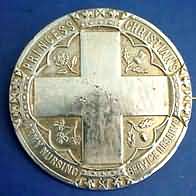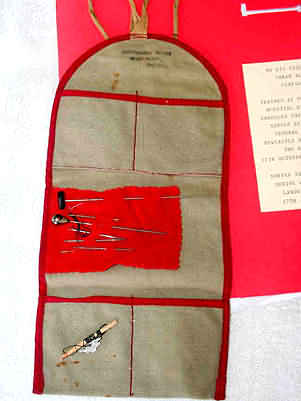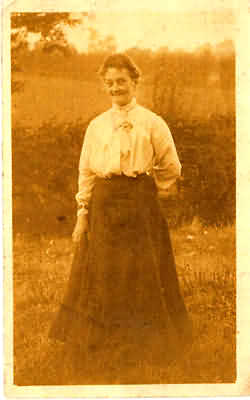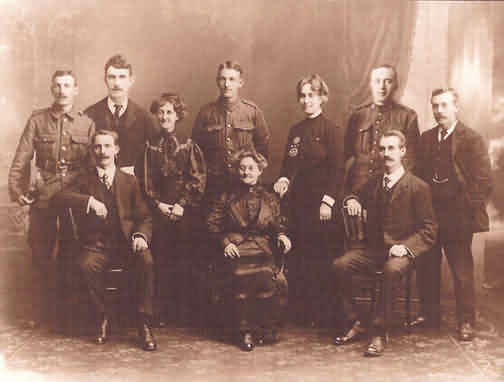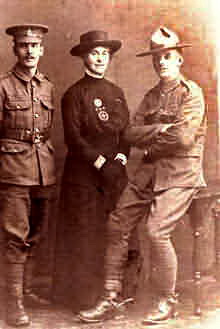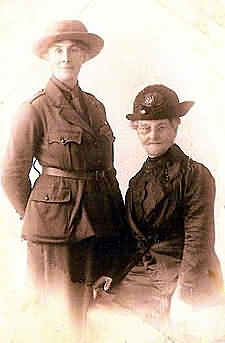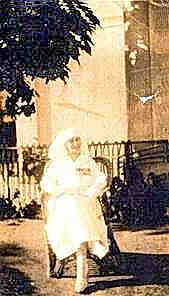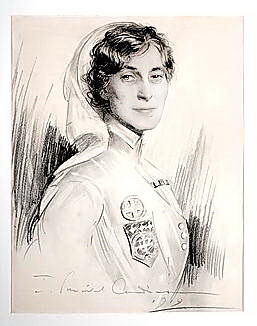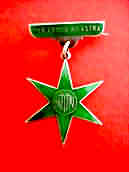|
Collecting Nursing History 55 Sarah ‘Alice’ Claridge, 1872-1957 Sarah Rogers |
 |
Please Note: Whilst every care is taken in checking promoted links, we cannot accept responsibility for your use of third party web links. | |||||||||||||||||||||||||||||||||||
Alice had a
very distinguished nursing career: she served in the Boer War, World
War One as Matron in Chief of the Order of St John and as a Sister
on the Western Front in France. She worked in Egypt and Africa after
the war, travelling widely.(1)
She continued to serve during World War Two, caring for men at the
Overseas Club in Aldwych.(2)
Portrait Medals: Left side: L: R: Queens South Africa; Kings South Africa; 1914-1915 Star; British war medal; and the Victory medal. Right side: Princess Christian Nursing Reserve cape badge, number 623. Three ‘pips’ - Rank badges.
Hanging
star on bar is possibly the badge of the Trained Nurses Institute,
or that of the Royal British Nurses Association, and beside it the
little hanging badge with red cross is a possible St. John’s
Ambulance/ Red Cross badge? Under three pips is?? an award from St
John the Ambulance.(3) Family records state that Alice was also awarded the Royal Red Cross; it has not been possible to verify this on the Royal Red Cross Register.(4) Her Princess Christian Nurses badge was recently purchased by Will inside an original packed folder (stamped 'Government House Work Party, Pretoria) possibly issued in 1898. It also contained two WW2 medal ribbons for the Italy star and 1939-1945 star which are thought to be research ‘red herrings’; two hat or hair pins; three sewing needles (one still threaded); a knob pin; and, a stick resembling a match stick with a little thread wound on and a little silver paper, possibly from a cigarette packet. It is too be reunited later in the year with a great niece of Alice’s. It is not known where her medals are...
Birth and family:
Alice’s mother - Emily/Polly Sarah Alice Claridge was born on 3rd February 1872, to her father Joseph Claridge, a railway labourer and his wife Emily Wilkinson Claridge, nee Brook.(5) Sarah was the third of nine children; she had one older half sister Mary and a brother James born two years before her.(6) Her brother George who was born in 1886 is grandfather to her great niece Patricia Mumford. In 1891 aged 19 Alice is working for a family in Southport as a domestic nurse; she would have been employed to care for the two young children in the house.(7) A niece, Maude Mumford, nee Claridge recalled that …'a family for whom she worked paid for her to train as a nurse'…(8) Alice was employed by Staffordshire Nursing Institute at some point between 1891 and 1895; in 1895 she was living in Hartshill Nurses Home when she was sent by the Matron to train at Birmingham General Hospital. Alice was aged 23 years when she commenced her nurse training, a typical age for a probationary nurse in that period.(9) Following her training she worked for two years as a private nurse for the Staffordshire Nurses Institute from 1897-1899 and then returned to Birmingham General Hospital in 1899.(10) Boer War Service: Alice had a spirit for adventure and service; she was also the only nurse from Birmingham General Hospital to enlist with Princess Christians Nursing Service Reserve.(11) In June 1900 Alice joined the Army Nursing Service Reserve aged 28 years and embarked for South Africa on Saturday 30th June with several other nursing sisters.(12) Soldiers of the Second Boer War were almost as equally likely to die of disease as to be injured: of the 20,000 British soldiers who died some 12,000 deaths were caused by typhoid fever, dysentery and other intestinal infections.(13) Service as a nurse in the Second Boer War (1899-1902) was also extremely hazardous- several nurses caught typhoid fever and some also died from it. The Second Boer War demonstrated that the pre-war Army Nursing Service was totally inadequate during warfare and ultimately led to the formation of the Queen Alexandra’s Imperial Military Nursing Service (QAIMNS).(14) Alice worked as both sister and Matron in Number 14 General Hospital Newcastle during the Boer War.(15) Following the end of the war worked as a sister at the Beira and Mashonaland Railway hospital in Beira in Portuguese East Africa.(16) Following the hospitals closure she travelled to Matopa and stayed with Cecil Rhode’s agent, and was present at the unveiling of the Bower War Memorial, where she learned of a shortage of nursing sisters with expertise in tropical diseases.(17) She was promoted to Matron in 1904 of the Shire Highlands Railway Hospital, Chiroma (Nyassaland), in British Central Africa.(18) The journey from the Victoria Falls to Chiromo took Alice four months and included crossing three rivers including the Zambesi. The hospital had previously been a naval officers shooting box, and with no ventilation by 0600 reached temperatures of 120 degrees, which Alice described as ‘...like an oven in the Potteries.(19) Alice appears to have enjoyed working in such hostile and challenging environs; in Chiroma she was the only white woman in the area. The local doctor was often ill and she performed both the matron’s and the doctor’s duties.(20) Her knowledge of tropical diseases was essential; she taught the local people to care for men with dysentery, Blackwater fever and malaria. Unsurprisingly she contracted malaria in 1905 and returned to Birmingham where she worked at the hospital before moving to ‘…the Children’s Hospital in London…(21) In 1906 she
travelled to Egypt where she organized local hospitals, taught child
welfare, passed on British nursing methods and nursed members of the
Egyptian royal family and was instrumental in the formation of Girl
Guides there.(22)
Alice left Egypt in June 1914 and travelled to Berlin with an
introduction from the International Council of Nurses in order to
inspect some hospitals.(23)
She was denied entry and continued to Denmark where she had a
friendly welcome.(24)
She visited several European countries including: Crete, Denmark
Germany and Austria.(25)
First World War: Standing L to R: George (Patricia Mumford’s grandfather) born 1886, Herbert born 1881, Mary born 1866, Sarah Alice born 1872, William born 1888, Joseph born 1875, Seated L to R: Alfred born 1879, Emily (their mother) born 1846, Harry born 1876. Both James the eldest son born in 1870 and their father Joseph predeceased the photograph. Alice was in
Austria on the day of the Archduke Ferdinand’s assassination and
returned home immediately to enlist. She was appointed Matron in
Chief of St John Ambulance Association and she is credited with
largely reorganizing the Foreign Service and Trained Nurses
Department.(26)
This involved the recruitment of nurses to staff units and whole
hospitals who would work on the frontline in France and Belgium and
who spoke French, German and Flemish. In early November 1914 Alice
had been called up for duty in Norwich by the A.N.S.R and by 7th
January 1915 Alice was working in France.(27)
Without Alice’s WW1 service records which have not survived the
1930’s cull, it is difficult to search the relevant War diaries.(28) However her medal cards state that Sister S.A. Claridge who
was a member of the QAIMNS Reserve was awarded the WW1 trio of
1914-1915 Star, British War Medal and Victory Medal, which she is
wearing in the photograph on her left breast.(29)
Her family recall that she was on active service in France and was
presented to both Queen Mary and Mrs Lloyd George.(30)
Alice with her brothers George (L) and Arthur (R)
Alice and her mother Emily (seated). Alice became associated with the International YMCA, but the ceasefire curtailed her activities and she diverted her attention to the nurses’ registration movement.
Inter War Years: Alice in tropical uniform, circa 1921. In 1919 Alice travelled to Egypt from the Port of London where she worked for another four years.(31) Alice’s name may occur in the historical nursing journals in 1922 and 1924 as presenting and chairing high profile conferences and lectures which appear to be in London. Alice registered as a State Registered Nurse in October 1924, her registration number was 33464. She stated that she had trained from 1895-1897 (Certificate) and from 1899-1900 at Birmingham General Hospital, presumably including the latter year to meet the criteria for three years training. By 1937 Alice
aged 65 had become the matron of a nurse’s home in London. In 1942
she is reported in several papers as stealing the limelight outside
the gates of Buckingham Palace where she was waiting to see a
relative Douglas Fisher who had received the British Empire Medal
for gallantry during the air raids on Coventry.(32)
By then she would have been 70 and is described as a ‘…little old
woman, wearing the medals of two wars…(33)
The paper continues ‘To-day Miss Claridge is hostess to the
servicemen of many nations at the Overseas Club. To thousands all
over the globe she is just ‘matron’. They did not know her name but
they all love her.’(34)
She visited her brother Joseph in the Barony hospital, Nantwich
several times in 1943.(35)
At the age of 77 she had a serious accident in 1949 which restricted
her mobility and she died in London in 1957 aged 85.
Portrait of Sarah Alice
Claridge This is in the
style of a number featured in The Tatler from October 1917,
described as ‘Portraits of Power’.(36)
Lieutenant Percival Anderson was born in York in 1885, and had
trained at York School of Art, Fraser College in Arbroath and Paris.
He worked mainly as a portrait painter of as The Tatler said
…'beautiful women'…(37)
During WW1 he served in the Army Service Corps, and the two other
image of women, The Marchioness of Londonderry and Mrs Burleigh
Leach are also painted in a soft and feminine style- unlike the more
severe drawings of the men. Professional Union for Trained Nurses
This is thought
to be the award which can seen in the photograph of Alice hanging on
her top right breast. She was one of the founder members of the
union, and eventually became its president. The union was eventually
amalgamated into COHSE. Members recall her attending London meetings
to discuss the ‘Limitation for Hours of Duty’.(38)
Nurses Registration movement: Alice was also
described as having led the fight for nurses’ registration, to-date
it has not been possible to link her name to that of the leaders of
the registration debate such as Mrs Bedford Fenwick. Alice was a
member of the Royal British Nurses Association (RBNA) which she
joined as member 4029 in November 1905. This was the first register
of trained nurses and the forerunner to the general Nursing Council
Register of nurses.(39)
Character: This description of Alice by her great niece sums her up well: Sarah Alice
Claridge was clearly an intelligent and dedicated nurse. She showed
tremendous courage and had a wonderful spirit of adventure,
travelling widely in Africa and Europe and participating in three
wars at a time when medical resources were extremely limited. She
contacted malaria and must have been exposed to numerous infections
when immunisations and antibiotics were unavailable. She was
therefore physically fit and healthy. She had a gentle and caring
nature yet had great strength and determination. She played a
prominent part at the Royal College of Nursing and wrote with
interest and enthusiasm. Early photos show her with a twinkle in her
eye. She mixed with many prominent people in London yet never forgot
her roots and was held in deep affection by her family. Acknowledgements: Dr. Patricia Mumford (Great niece); Lt. Col Dr. Kieron Spires; Will Burgess and Peter Maleczek.
1. Sarah Alice Claridge was known by her family as Alice, she is also referred to Alice in some historical nursing journals. 2.
As with any research some of the family information may have
‘ red herrings’ in, indeed some dates supplied by Alice
herself
3. The St. John Museum administrator was unable to
find any records which verified that Alice had either worked
for St. John, was 4. http://search.findmypast.co.uk/search-world-records/register-of-the-royal-red-cross-1883-1994, accessed 31 December 2015. 5. General Register Office, Register of Birth for Sarah Alice Claridge. 6. Mary was born illegitimately three years before her mother married Joseph. It is not known who her father was.
7. The National Archives, 1891 England and Wales
Census, RG12/3036/69/1, accessed via www. Ancestry.co.uk 29
December
8. Taken from notes by her great niece Patricia
Mumford, 2009; if her employers the Bradbury family did pay
for her to train then this
9. The City of Stoke–on-Trent Bi-Monthly Review, July
1952, p2; the family may have paid for her to be trained by
the Staffordshire
10. Taken from notes by her great niece Patricia Mumford;
The British Journal of Nursing, 1 October 1904, p.264; 11. BJN, 3 October 1914, p260.
12. The Nursing Record and Hospital World, 30 June 1900,
p.514;
http://britisharmynurses.com/wiki/index.php?
13.
,http://blogs.ancestry.com/au/2010/07/05/horrors-of-the-boer-war-revealed-in-historic-casualty-lists/ar-revealed-in-historic-
14. C. Dale, ‘Raising
professional confidence: The influence of the Anglo-Boer war
(1899-1902) on the development and recognition 15. BJN, 3 October 1914, p260. 16. http://britisharmynurses.com/wiki/index.php?title=Special:IframePage/Database, accessed 29 December 2015. 17. The City of Stoke–on-Trent Bi-Monthly Review, July 1952, p2. 18. BJN, 1 October 1904, p.264. 19. The City of Stoke–on-Trent Bi-Monthly Review, July 1952, p2. 20. The City of Stoke–on-Trent Bi-Monthly Review, July 1952, p2.
21. The City of
Stoke–on-Trent Bi-Monthly Review, July 1952, p2; it is not
known which children’s hospital this refers to, there were 22. Taken from notes by her great niece Patricia Mumford, 2009; The City of Stoke–on-Trent Bi-Monthly Review, July 1952, p2. 23. BJN, 3 October 1914, p.260. 24. BJN, 3 October 1914, p.260. 25. Taken from notes by her great niece Patricia Mumford, 2009. 26. BJN, 30 January 1915, p87. 27. BJN, 7 November 1914, p.367, Miss Swift was her successor. 28. Now available online via the National Archives.
29. www.ancestry.co.uk,
accessed 29 December 2015;
http://www.nationalarchives.gov.uk/help-with-your-research/research- 30. BNJ, 2 June 1917 p.386 31. Family information.
32. Manchester Evening
News, Thursday 26 February 1942, p.1,
33. Manchester Evening
News, Thursday 26 February 1942, p.1,
34. Manchester Evening
News, Thursday 26 February 1942, p.1, 35. Family information. 36. http://blog.maryevans.com/2013/06/portraits-of-power-by-lieutenant-percival-anderson.html, accessed 30 December 2015. 37. http://blog.maryevans.com/2013/06/portraits-of-power-by-lieutenant-percival-anderson.html, accessed 30 December 2015. 38. D. Westmacott, Sarah Claridge, a pioneering nurse PUTN, COHSE Journal 1957. 39. http://www.kingscollections.org/nurses/a-c/claridge-sarah-alice-4029?searchterms=claridge, accessed 30 December 2015.
40. http://www.kingscollections.org/nurses/a-c/claridge-sarah-alice-4029?searchterms=claridge,
accessed 30 December 2015. |
SECTION
1 SECTION 2 |
||||||||||||||||||||||||||||||||||||
(7)
| Home Schools Region Forum Collecting Galleries History Bibliography News Archive Contact |
